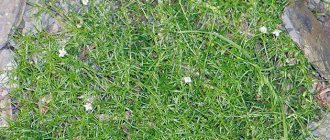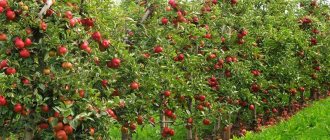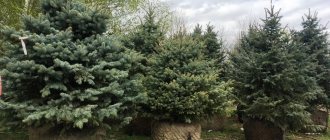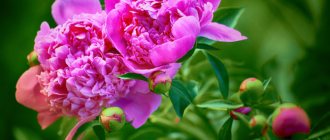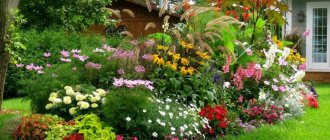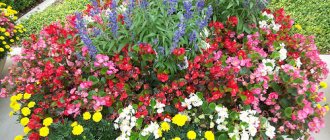Compositions in which flowering plants are used in very small quantities or not at all are becoming increasingly popular among home garden owners. Is there a future for a “flower garden without flowers” and how to create such a flower bed on your site?
When creating a garden on our site, we usually imagine a space that pleases the eye at any time of the year. However, once you start planning flower beds, it turns out that arranging a flower bed of continuous flowering requires not only a good knowledge of theory, but also certain practical skills, which are especially lacking for novice gardeners.
Sometimes factors interfere with the process of creating the ideal flower garden that cannot be influenced. Not very favorable soils, shading from nearby buildings or forest plantations, inability to devote more time to caring for the flower garden... Can all this really prevent you from realizing the dream of a flowerbed that would retain its attractiveness throughout the entire season, and not just during certain periods? months? The solution to the problem lies on the surface: if we cannot enjoy the diversity and tenderness of flowering crops, then nothing will stop us from taking advantage of all the benefits that the richness of shapes and textures of other plants gives.
What should you consider when choosing?
The primary task of landscape design is to create a unique image of the garden plot. Choosing green spaces is a complex job, during which several important nuances have to be taken into account. First of all, you need to pay attention to the biological compatibility of the specimens you like.
When selecting outdoor plants, you should take into account the climatic conditions of a particular area, the composition of the soil, the level of groundwater and the degree of air pollution. The amount of light also plays an important role. Experts recommend making compositions from specimens that are considered endemic to your region. This group includes lawn grasses and unpretentious shrubs.
Classification of green spaces
All outdoor ornamental plants, often used in garden design, can be divided into several main types. The first group includes fruit, deciduous and coniferous trees. The latter are good because they do not require specific care. In addition, they delight the eye with their green crown throughout the year.
The second group includes climbing, flowering, ornamental and berry bushes. The third category includes ground cover specimens. Prominent representatives of this group are considered to be lawn grasses (timothy, bluegrass and meadow clover), creeping juniper, periwinkle and thyme.
The next broad group includes annual and perennial flowers. They differ in color, height and appearance. Aquatic plants are no less popular among landscape designers. The most popular representatives of this category are marigold, duckweed, calamus and water lily.
In recent years, on open verandas, paved courtyards and areas close to the exit of the house, you can often see so-called container plantings.
Disembarkation
What to sow in February:
What to sow in March:
What to sow in April:
Self-sown flowers can be distinguished into a separate group. In the fall, their seeds fall, are spread throughout the garden, and the plants sprout safely on their own in the spring. These include:
- calendula;
- Eschscholzia;
- lobularia;
- Snapdragon;
- petunia;
- lavatera;
- forget-me-not;
- morning glory;
- cosmos;
- cornflowers, etc.
Photo:
As for bulbous perennials, in the fall you need to have time to plant hyacinth, crocus, narcissus, scilla, pushkinia, tulip, hyacinthoides, kandyk, chionodoxa, iridodictium. In spring - gladioli, lilies, freesias, acidanthera, dahlias.
Rock juniper Blue arrow
The name of this plant translates as blue arrow. It has a narrow columnar crown with rigid, vertically growing shoots that fit tightly to the trunk. The average height of a ten-year-old specimen is about two and a half meters.
A distinctive feature of this plant is the scaly soft needles of a bright blue hue and bluish-blue fruits. The lower branches, growing almost from the very base of the trunk, retain their freshness for a long time. Therefore, Blue Arrow rock juniper is considered a valuable variety. It is often used to create landscape compositions from deciduous and coniferous trees. It looks equally impressive in free-growing mixborders and as part of small single-varietal groups.
It is also important that juniper is quite unpretentious. It does not require complex specific care. It is advisable to plant these evergreen outdoor plants in sunny areas with slightly acidic or neutral soil. Juniper does not tolerate dry air well, so it needs regular sprinkling. For the winter, it must be sprinkled with a ten-centimeter layer of peat.
Southern flowers: trees, shrubs and perennials
Hibiscus Hibiscus
Most often, it is hibiscus that attracts the attention of a botanist-tourist photographer. Huge flowers are visible from afar, and it is simply impossible to pass by!
Hibiscus are evergreen trees or shrubs with large single or double flowers of various colors. They can have flowers of white, yellow, orange, lilac, and all shades of pink. There are also two-color varieties.
Most often you can find one of two types: Chinese hibiscus or Syrian hibiscus.
Chinese hibiscus, Chinese rose, Chinese rose, swamp mallow, "flower of fair ladies", Hibiscus rosa-sinensis
Shrub or tree, in nature up to 4–5 m tall, variegated forms are found. Flowers are up to 10–12 cm in diameter, white, yellow, pink, red or purple. The peculiarity of flowers is that they live only for a day. However, the plant can bloom throughout the year.
Chinese hibiscus or Chinese rose flower. Photo taken in Israel.
Syrian hibiscus, or ketmia, or Syrian rose, Hibiscus syriacus
Shrub up to 4 m in height, native to China and India. Flowers up to 10 cm in diameter, color from white to crimson and even lilac with a burgundy center, simple and double. There are variegated varieties.
Syrian hibiscus blooming. Photos were taken in Israel in early June.
Common oleander, Nerium oleander
Unless the lazy one has never photographed the huge caps of oleander flowers. This evergreen, upright shrub in nature can reach a height of 2–3 m. Flowers of various colors (white, orange, pink and red) can be simple or double.
Almost all parts of the plant are poisonous, so you should handle it very carefully.
Common olendra flowering. Photo taken in Greece.
Pomegranate, Punica
Trees and shrubs with narrow elliptical or lanceolate leaves and numerous bright red small flowers are pomegranates. The Pomegranate family itself is represented by only one genus, in which there are only two species - the common pomegranate and the Socotran pomegranate. The most common pomegranate is the common pomegranate, and its Nana form can be grown even indoors.
Flowering of the common pomegranate. The photo was taken in May in Egypt.
Yucca Yucca
A plant with a short trunk and a crown of long leathery or sword-shaped leaves of various colors, including variegated ones. Yucca is native to the humid subtropical forests of the United States and Mexico. The most common cultivated species is elephant yucca (Yucca elephantipes), its sword-shaped leaves reach a length of 50–100 cm. You can also find glorious yucca (Yucca gloriosa). This species is distinguished by a shorter trunk and sword-shaped, spiny-pointed leaves.
Yuccas are unique for their flowers: white with a reddish tint, up to 7 cm long, collected in large pyramidal inflorescences. In cultivation, yuccas bloom very rarely, but in nature the flowering is magnificent.
Another interesting thing about yucca: its fragrant petals are edible. The Indians used them in cooking: they collected the petals and added them to vegetables.
Yucca flowering. Photo taken in Morocco.
Jacquaranda, fern tree, violet tree or rose tree, Jacaranda
Trees with huge purple inflorescences are, of course, jaccaranda! A plant of the Bignoniaceae family, native to South America. The name comes from the Guarani language and means “fragrant”: the aroma of jaccranda flowers is reminiscent of honey.
Jacquaranda can reach a height of 30 meters. Blooms twice a year.
The bark of the tree is also interesting: its color varies from red to chocolate with a purple tint.
Flowering jacquaranda. The photo was taken in France in June.
Callistemon, Callistemon
If you see a plant with red brush flowers, then this is a callistemon, an evergreen plant with narrow long leaves. The flowers have greatly reduced petals, but have many bright red stamens, which form such unusual inflorescences.
Callistemon can be grown indoors and in greenhouses.
Callistemon flowering. Photo taken in Australia.
Royal Delonix, or fire tree, Delonix regia
Fire tree - delonix - is native to Madagascar. The height of delonix is relatively small, up to 10 m. Most often it is planted in parks or squares, making bright alleys out of it, which during the flowering period simply blaze with scarlet fire.
The plant has an interesting feature: its leaves fold at night.
Blooming delonix magnificent. The photo was taken in Israel in early June.
Plumeria
You have come across a flower that you have definitely seen somewhere before. Perhaps in American films, in the hair of girls vacationing in Cuba?! Then you've seen plumeria! This plant has long won the love of southern beauties thanks to its large fragrant flowers. There are several basic color shades: white with a yellow center, yellow, red and multi-color.
In general, plumeria is a large shrub with leathery leaves, native to Puerto Rico and the Lesser Antilles.
Plumerias are poisonous!
Plumeria blooming. Photo taken in Tunisia.
White plumeria (Plumeria alba) is suitable for growing in greenhouse and indoor conditions, blooming with white flowers with a strong aroma of almonds.
Calliandra, Calliandra
What many tourists mistake for acacia or mimosa, in fact most often turns out to be calliandra! In nature, calliandra grows in the tropical forests of South America, Africa and India. Its leaves are carved and pinnate, reminiscent of the leaves of an ordinary rowan.
Due to the stamens, the flowers look like fluffy pompoms. It is because of them that the plant got its name, which is translated from Greek as “beautiful stamens.”
Calliander flowering. Photo taken in Spain
Brachychiton, Brachychiton
Most often, the imagination of travelers is struck by the maple-leaved brachychiton (Brachychiton acerifolius), which grows naturally on the east coast of Australia. Brachychiton maplefolia is an evergreen tree up to 30-35 m tall. Its leaves resemble maple leaves: leathery, up to 20 cm in length.
Brachychiton maple-leaved is also known as the “tree of happiness.” Feng Shui experts recommend growing it at home to attract good luck.
Flowering of Brachychiton maplefolia. The photo was taken in Israel in early June.
Carissa, Carissa
A shrub with white fragrant flowers is interesting for photography. This is carissa, a plant native to the tropical regions of Africa and Asia. In decorative landscaping of hotels located on the seashore, large-flowered carissa (Carissa grandiflora) or large-fruited carissa (Carissa macrocarpa) are most often used.
All parts of the plant, with the exception of the fruits, are poisonous. Carissa fruits are edible when fully ripe.
Fruits and flowers of Carissa largefruited. Photos were taken in North Africa.
Cassia, senna, Cassia
The yellow flowers, collected in racemes and immediately attracting attention, most likely belong to cassia. These are shrubs or subshrubs with pinnate leaves, blooming with bright yellow flowers.
Cassia is native to the tropical regions of America.
Flowering of cassia and senna in July. Photo taken in Italy.
Lantana
Lantana grows almost everywhere in the south, its homeland is tropical America. In the southern regions it can be found in almost any park or square. It is also very popular as a container crop.
Lantana is an evergreen shrub with small flowers of various colors (usually yellow or pink), collected in dense axillary umbels.
The most commonly grown plant is lantana camara, or spiny lantana (Lantana camara), which blooms profusely throughout almost the entire season. The inflorescences come in white, pink, yellow, red, purple and even two-tone colors. During the flowering process, most flowers change color.
Lantana blooming. Photo taken in Cyprus.
Indian lilac, or lagerstroemia, Lagerstroemia indica
If while traveling around the Mediterranean you saw lilacs, then you became acquainted with lagestremia. In open ground, Indian or southern lilac can reach 10 m. Its flowers are larger than our lilacs and can be white, pink, crimson or purple.
By the way, despite its name “Indian”, this plant comes from China.
Blooming lagerstroemia, or southern lilac. The photo was taken in May in Italy.
Buddleja, Buddleja Buddleja
Strictly speaking, buddleia is not so southern - it is quite capable of growing in central Russia and in the Moscow region. But, unfortunately, in our country it will never reach that size and will not bloom as spectacularly as in the south, where it can grow up to 4 m in height!
Buddleia has a wonderful scent, is pollinated by large butterflies, and is often called a “butterfly magnet.” In addition, during flowering, buddleia somewhat resembles lilac, for which it is called “autumn lilac.”
Buddleia is native to tropical and subtropical regions of America, Asia and South Africa. In southern ornamental gardening, about 10 species are used; in temperate climates, the only species is Buddleja Davidii, or Buddleja davidii. In culture since 1890. White-flowered forms are available. The most resistant varieties are those with purple flowers.
Blooming Buddleia David. The photo was taken in May in France.
Agapanthus, Agapanthus
Synonyms: agapanthos, Nile or African lily, “Abyssinian beauty”.
A beautifully flowering bulbous plant with strong, ribbon-shaped leaves. Bell-shaped flowers. The color of the flowers varies from light blue to dark blue, sometimes with a purple tint; white agapanthus are also found.
Most agapanthus have a long flowering period from July to September. Agapanthus campanulatus hybrids, also known as Headboume, can be grown in pots at home.
Agapanthus in a flower garden. Photo taken in Montenegro
Heliconia, Heliconia
Heliconia is a perennial herbaceous plant with large leathery leaves and multi-tiered spike-shaped inflorescences. Most often, tourists like to photograph Heliconia rostrata, better known as the “crab claw” or “lobster claw”. The names were assigned to the plant of this variety because of the bright red inflorescence with yellow-green tips and the regular, classic shape of the bract. In fact, heliconia has become the “face” of the family. In addition, it is one of the largest heliconias. The plant reaches a height of 3–6 m.
Less often the attention of tourists is attracted by:
- Parrot heliconia (Heliconia psittacorum) - vertical inflorescence, flowers with black tips. Bracteas are bright orange to red. The height of the plant does not exceed 1.8 m.
- Heliconia stricta is a heliconia with a straight inflorescence, the plants themselves are from 30 cm to 1.5 m high. The inflorescence looks a little like a bird spreading its wings - sharp, oblong bracts of bright red color.
- Indian heliconia (Heliconia indica) blooms in small, cascading inflorescences (usually green).
- Heliconia bicolor grows up to 1 meter. The flowers are white, arranged in 2 rows, the covering leaves are red and other types.
Heliconia parrot and Heliconia rostral, or "lobster claw", photos taken in India.
Red spruce
This is a tall coniferous plant with a loose crown of a narrow pyramidal or wide conical shape that descends to the ground. The diameter of the grayish or reddish-brown trunk can reach 130 centimeters.
The seeds of this plant do not need stratification. They are sown in bowls filled with substrate and placed on the windowsill until germination. After this, they are transplanted into the ground. Red spruce is unpretentious in everything related to soil composition. But it grows best in moist, well-drained soil. It tolerates drought well. In landscape design it is used to create group and single compositions.
Southern succulents
Agave
Tourists are amazed by the huge inflorescences, much taller than human height, emerging from aloe rosettes. No and no, it's not aloe, it's agave! Most impressive, of course, are the inflorescences of the American agave.
It is believed that agave blooms on its 100th anniversary, but this is not true: large species of agave bloom at 30-40 years of age, and miniature ones after a couple of years. By the way, they bloom only once in their life, then they die, leaving behind numerous root shoots. Interestingly, in some species, instead of flowers, young plants with roots appear on the inflorescence, which are capable of self-rooting.
The American agave, or centenary aloe (Agave americana), originates from Mexico, but has taken root well throughout the Mediterranean. This is a large perennial succulent plant with powerful, fleshy, succulent leaves collected in a basal rosette, the diameter of which in adult specimens can reach 3 m.
The inflorescence can reach a height of 10 meters or more and bear about 10 thousand bell-shaped yellow flowers up to 7 cm in diameter.
The name comes from agauos, which translated from Greek means “noble”, “wonderful”, “excellent” and it received it in honor of Agave, the daughter of one of the ancient mythical kings.
Agave americana flowering. Photo taken in Sicily.
Aloe
The ordinary tree-like aloe used to grow in almost every home, but it rarely bloomed, which is why it got its apt name “agagave.” In natural conditions, it blooms much more often, and many tourists are surprised at the beauty of its flowers, not recognizing their grandmother’s agave in this blooming beauty.
The genus Aloe (Aloe) itself includes about 340 species of perennial succulent plants, common in tropical regions of Africa, Southern and Eastern Africa, the island of Madagascar and the Arabian Peninsula. Among aloe there are both dwarf varieties with a rosette several centimeters high, and giants up to 10 m high, with a trunk diameter of up to 2 meters.
Externally, aloe is similar to agaves, but in nature, aloe blooms annually and the rosettes do not die off after flowering. Their inflorescences are smaller (maximum size 1.5 m tall), with small tubular flowers, usually yellow or red in color.
The most interesting types:
- Aloe tree, sabur, agave (Aloe arborescens) - in nature, their height is about 3 m or more. Peduncle about 80 cm long with a multi-flowered racemose inflorescence with red flowers, yellow inside.
- Aloe plicatilis, or Aloe plecatilis (Aloe plicatilis, Aloe lingua, A. linguaeformis, A. tripetala) - the species has unusual leaves for aloe: belt-shaped. The inflorescence is a simple raceme on a peduncle about 50 cm long, bearing 25–30 red flowers.
- Aloe variegated, or tiger aloe, “falcon feather” (Aloe variegate, Aloe punctata, A. ausana) - 30 cm high. Flowers up to 3.5 cm long, color from pink to dark red or scarlet with green stripes, yellow inside .
- Aloe vera, aloe Barbados, aloe vera (Aloe barbadensis, Aloe vera) - the peduncle has a height of 60–90 cm.
Aloe shortleaf (Aloe brevifolia) is a miniature species, rosettes up to 8 cm in diameter. Photo taken in Spain.
Opuntia
Probably the most favorite flowering cacti among tourists! Not a single photography enthusiast has ever left the sea without photographs of blooming prickly pear. Its yellow and orange flowers adorn many traveler's photo albums.
The prickly pear is native to North and South America. These are succulent plants with flat, disc-shaped stems and large, often multi-colored flowers of varying colors. By the way, some types of prickly pear have edible fruits! They are sold in Mediterranean countries, often already peeled, and eaten fresh.
The most famous is the ficus-indica prickly pear (Opuntia ficus-indica). It is precisely its fruits that are edible.
Prickly pear blossom, photo taken in Spain
Pereskia, Peireskia, Pereskia
The pretty pink flowers belong to Pereskia, the most common being Pereskia grandifolia (Pereskia grandifolia), native to Brazil.
Kstity, it’s very interesting that this is... CACTUS! More precisely, all pereskias are leaf cacti that bloom with rather large fragrant flowers.
Pereskia grandiflora in flowering period, photo taken in Spain.
Another interesting species is Pereskia aculeate, Cactus pereskia, native to Brazil, Uruguay and Argentina. Its flowers are yellowish-white with a pink tint in the center and are lightly scented. But the fruits are edible, yellow in color.
Garden hibiscus
These are very beautiful outdoor plants that are especially popular among our compatriots. They can often be seen on terraces, balconies or gardens. This member of the mallow family is easily recognizable due to its large, elegant and bright flowers.
The height of garden hibiscus does not exceed one and a half meters. Therefore, it fits perfectly into a shrub or mixed border. It is often used to create compositions with ground cover roses or lavender.
These outdoor plants are planted in the spring. Young specimens need additional protection from the wind. Heat-loving hibiscus needs plenty of moisture and sunlight. It is advisable to water it little by little, but every day. In shaded areas it begins to grow poorly and bloom worse. In regions with cool climates, it is preferable to plant hardier varieties.
Badan
This plant (number 6 in the photo) has become widespread as a garden plant throughout the world. The shrub grows up to 40 centimeters in height. Its stems are covered with glossy green oval-shaped leaves, and in spring they bear pink inflorescences reminiscent of hyacinths.
According to experienced gardeners, bergenia grows much better in containers than in open ground. This is due to the fact that drainage provides better drainage of water, an excess of which is detrimental to the plant. In the garden, plants can be kept both in the shade and in the sun. But if you live in a region with harsh winters, then it is better to choose special frost-resistant containers for bergenia.
Garden ivy
This is an evergreen vine whose height reaches several meters. Today there are many varieties of ivy known. But only a few of them are particularly popular. Most often you can see common and Colchis ivy. Moreover, the first one has many decorative forms. It is winter with large light leaves, Baltic, palmate and marbled.
These vine-like outdoor plants require partial shade. They are planted on moist soils with a high content of humus and lime. Garden ivy propagates by cuttings, which need to be cut in the summer. In the autumn months, all dry shoots must be removed from it. For the winter, it is advisable to cover the ivy stems with oak or apple leaves.
Sedum false
This variety is distinguished by bronze leaves that turn red in winter. The flowering period begins in late spring, when the shoots are covered with cherry buds. The bushes reach a height of only 15 centimeters, but they grow up to 30 cm in width. False sedum (number 10) will feel best in a container if placed in an open and well-lit place, but if this is not the case, then there is no problem will happen if the plant is in partial shade.
These perennial plants are best suited for growing outdoors in pots because they combine attractive appearance, ease of care and resistance to cold weather. So if you want to decorate your garden without putting in too much effort, then definitely consider them. It is unlikely that you will be able to find a perennial plant that would be better suited for this role.
Finally, I would like to note that plants give us positive emotions due to their beauty, and also take away all the negativity.
Found a violation? Report content
Yucca garden
These heat-loving, drought-tolerant perennial outdoor plants have an exotic appearance. They are very similar in shape to Mediterranean agaves. But they differ from them in having rather dense sword-shaped leaves.
It is advisable to plant yucca on sandy or clay soils enriched with humus. It needs sufficient heat and light, as well as moderate watering. In the process of adjusting the humidity regime, you need to pay attention to the appearance of the plant. With insufficient watering, the dense, well-spread yucca leaves begin to curl. It is also important to ensure that there is no stagnation of water. Excess moisture can cause rotting of the plant's root system.
In winter, it is advisable to bring the garden palm tree indoors. If for some reason this is not possible, then the yucca leaves should be tied into a bundle and covered. The soil around it needs to be insulated with fallen leaves or agrofibre.
Heuchera
This is a low-growing perennial plant with an attractive appearance. A distinctive feature of heuchera (number ) is the lobed leaves of green or purple color with silver veins. They are ideal for growing in containers because they love well-drained soil. They are unpretentious in choosing a place, so the shrubs can be kept both in direct sunlight and in shaded areas areas. They are unpretentious in maintenance. Watering is done as needed.
A distinctive feature of heuchera (number ) is the lobed leaves of green or purple color with silver veins. They are ideal for growing in containers because they love well-drained soil. They are unpretentious in choosing a place, so the shrubs can be kept both in direct sunlight and in shaded areas areas. They are unpretentious in maintenance. Watering is done as needed.
Fuchsia
This vibrant outdoor flower is a stunning sight to behold. Outwardly, it resembles the skirt of a dancing ballerina. Fuchsias love warmth very much, so they are planted in open ground no earlier than May. It is very important not to bury them in the soil. Thanks to intensive rooting, the first flowers appear within a couple of weeks after transplantation.
In general, this is a heat-loving plant that needs plenty of sunlight, moderate temperatures and sufficient humidity. Some blue-white varieties require careful watering and increased shading.
It is advisable to plant fuchsias in light, fertile soil. To improve the soil structure, you need to add sand, perlite or high peat. For adult plants, soils consisting of humus, compost and turf soil are suitable.
In the process of creating landscape compositions, large two-year-old specimens with a well-developed root system are most often used. Active growth and reproduction of fuchsia continues from spring to mid-autumn. In November, the bright outdoor flower is moved indoors for the winter. During the dormant period, it is necessary to stop fertilizing and reduce watering.
Boxwood Green Mountain
If this shrub (in the photo it is indicated by the number 2) is grown in open ground, then it grows up to 150 cm in height and 90 cm in width. When propagated in containers, its size will be smaller, but its decorative properties will not deteriorate. The main thing is to place containers with shrubs in a place protected from cold northern winds. Experienced gardeners recommend periodically rotating the pot so that the boxwood receives the same amount of sunlight on all sides. Otherwise, the foliage and buds will develop unevenly. A special feature of the “Green Mountain” variety is that it retains its color even in winter.
Rare shot: Viktoria Isakova showed her grown-up daughter from Yuri Moroz (new photo)
Smooth and fresh skin: dermaplaning, or why a woman needs to shave her face
It’s good to wash often: myths about shampoo and hair care that only harm
Flowers in pots
In recent years, it has become fashionable for owners of private mansions to decorate gazebos, terraces and cottage walls with hanging flower beds. As a rule, unpretentious flowering plants that do not require special care are selected for these purposes. Such flower garlands do not take up much space and create a cozy atmosphere in the area.
The most suitable flowers for flowerpots are achimenes. These outdoor potted plants come in a variety of varieties. They are easily recognized by their large funnel-shaped flowers. Depending on the variety, they can be purple, sky blue, red or white.
Lobelia is no less popular. It is often used to create spectacular garden compositions. Today on sale you can see varieties with purple, white, red and cornflower blue flowers.
Lovers of unusual soaring compositions often use petunia. The lush leaves of this plant create the impression of an airy green cloud strewn with flowers.
Thuja Smaragd
It is also called “emerald”. A characteristic feature of this variety (number 5) are leaves of a specific shape and texture that combine well with many other plants. Like many other perennial plants described above, Thuja Smaragd does not change its rich green color throughout the year, which is why it is of great interest to many gardeners.
"Dad is offended." Agata Muceniece about her relationship with Priluchny after the divorce
Lost weight: what Sofia Tarasova sacrificed for the sake of “VIA Gra” (new photos)
A student at the Vietnam Police Academy shared how she takes care of her facial skin.
Rhododendron
This flowering plant belongs to the heather family. Cultivated varieties can live up to fifty years. Rhododendrons have a branching crown and thin, smooth shoots.
The plant is suitable for moist, light, loose soil. On calcareous soils it quickly turns yellow and begins to shed its leaves. It is advisable to plant rhododendron in semi-shaded areas. Excess sunlight not only worsens the appearance, but also significantly shortens the flowering period. Experts recommend placing these outdoor plants next to other shrubs that will not inhibit their superficial root system.
Perennial flowers
Unlike annual plants, which need to be planted every year, perennials do not die by winter, but are revived the following season. Some species are “short-lived” perennials with a lifespan of only three to four years. Others can live as long as fifteen years or more. For the longest-flowering perennials, the flowering period is measured in months.
Interesting articles
Site development
Which climbing plants to choose for decorating a fence
Site development
18 Best Ornamental Plants for Fast-Growing Hedges
Garden care
How to cover different types of Hydrangea for the winter
Garden care
List of gardening work that needs to be done in November
Garden care
How to perform autumn pruning of Hydrangea paniculata
Site development
Phloxes
These perennial flowering plants tolerate frost well. In addition, they are quite unpretentious to grow and do not require special care. That is why they can often be seen in flower beds.
One of the most important conditions for successfully growing phlox is to ensure good drainage. There should be no stagnation of water in the area where this flower is planted. In addition, it is advisable to provide these plants with a sufficient level of illumination. Flowers growing in shaded areas are more likely to get sick.
Phlox prefer fertile, loose, slightly acidic or neutral soils. It is advisable to prepare the soil intended for growing these flowers in the fall. It needs to be dug up to a depth of thirty centimeters and fertilized with superphosphate, compost and wood ash. Caring for the plants themselves comes down to regular watering, loosening the soil and systematic feeding.
Boxwood
It is a slow-growing evergreen shrub that can reach six meters in height. It has oval dark green leaves. Often small cracks appear on the grayish-yellowish bark of boxwood.
In landscape design, this shrub is often used to frame flower beds and to create hedges. It is advisable to plant boxwood in the spring months. To do this, in a well-lit area where there are no drafts, you need to dig a fairly deep hole and fill it with compost. The distance between neighboring plants should be at least thirty centimeters.
Boxwood does not like dry air, so it must be regularly sprayed with soft filtered water. During the growing season, the plant needs systematic feeding.
Autumn flowering period
In order for the flowerbed to please you until the coldest weather, you must remember to plant flowers with an autumn flowering period. There are not very many unpretentious flowers with such late flowering, but they are no less decorative.
Autumn flowers for the garden are not so numerous
Crocuses
We are accustomed to the fact that crocuses are primroses. But this flower also has autumn forms. Moreover, they are larger and no less decorative.
- Beautiful crocus (Crocus speciosus). The leaves are bright green with purple longitudinal veins and can reach a length of 20 cm. The flowers are lilac-violet with purple veins. The flowers are large, up to 7 cm in diameter. They bloom in autumn. There are varieties with dark blue, white, lilac, light purple, and blue flowers.
Autumn crocuses are one of the most interesting options for rockeries, ridges - Pretty crocus (Crocus pulchellus). The height of the flowers is 7-10 cm, the diameter is 6-8 cm. The color is light purple with dark veins. Each tuber produces 5-10 flowers. It blooms in September-October and tolerates light frosts.
- Banat crocus (Crocus banaticus). Another autumn crocus. It has an interesting flower shape - with a slightly elongated, pointed edge. The color is soft lilac, the leaves are long, silver-gray. The flowers are large - 12-14 cm high, leaves - up to 15 cm. There are numerous hybrids (Dutch) with spring and autumn flowering periods and different colors.
Helenium autumn
A perennial plant that begins to bloom in mid-summer and lasts until frost. Plant height is from 50 cm to 150 cm. Plantings form large bushes. Each stem can have up to 10 flowers. Flowers - red, yellow, orange. Large, up to 6 cm in diameter. Prefers sunny places, soils rich in humus. The following species are found in gardens and flower beds:
- Helenium autumnal Altgold. stems are straight, up to 80 cm high. Reed flowers - yellow inside, orange-red outside; tubular - yellow-brown. Blooms in August-September, early November.
- Helenium autumnale Augustsonne. Flowers up to 4.5 cm in diameter, yellow. It is distinguished by its abundance of foliage and height - up to 90 cm. It blooms in August and the first half of September.
Heleniums bloom in late summer - early autumn - Helenium autumnalis Herbstrot. Reed flowers are variegated, orange-brown, tubular yellow with brown. Flowering time - August/early September.
- Helenium autumnal Cockade (Kokarde). The flowers are red with a brown tint, with yellowish edges. Very tall species - up to 120 cm. Abundant flowering in August/September.
There are many more types. There are also forms that bloom in summer; by the way, there are more of them. But there are not so many autumn flowers. And helenium should not be neglected.
Aster perennial Aster (September)
Despite the similar name, they should not be confused with annual asters. This is a completely different plant. There are compact border species, and there are medium and tall ones. Prefers well-lit areas, nutritious soils. Flowers - white, blue, red, light blue, purple. The flowering period for autumn species is September-October.
- Virginia Aster (Aster novibelgii) or New Belgian. Tall variety - up to 2 meters tall. Blooms in October, if weather conditions permit, also in November. Flowers are 2.4-3 cm in diameter, purple, red, violet-red, pink. The middle is yellow.
Perennial asters - autumn flower for the garden - Heather aster (Aster ericoides). Compact tall species - up to 1 meter in height. The flowers are numerous, small - up to 1 cm. The petals are narrow, white or pinkish in tone, the middle is tubular, of different shades.
- Side flower aster (Aster lateriflorus). Tall bush - up to 120 cm in height, flowers are located along the shoots. Starts to bloom in September. The flowers at this time are white, the centers are light pink. Later the centers become bright pink.
Low-growing varieties - alpine, shrub - can be used as borders or planted in rockeries. Tall ones are planted in the background.
We recommend:
Camellia garden
This two-meter plant is strewn with bright, large, single flowers in shades of pink, white or red. It does not have a pronounced characteristic aroma.
Garden camellia has a fragile and sensitive root system, so it is not advisable to replant it frequently. It is also important to ensure that the neck of the plant is not covered with soil. Otherwise it may die. The flower needs to be provided with sufficient air and light.
It is advisable to plant camellia in acidic soil, which contains sand, peat and perlite. Thanks to this, the plant’s roots will be evenly moistened, and the soil itself will be enriched with oxygen. Complex fertilizers containing nitrogen, phosphorus, potassium, sulfur and microelements must be systematically applied to the soil.
Dogwood
This plant (number 7) has very variegated leaves that do not change throughout the year. However, they are most beautiful only on young plants, so the bushes need to be rejuvenated every spring.
There are many varieties of dogwood, each of which is beautiful in its own way and is well suited for growing in flower pots. But it is important to remember that this shrub has a powerful and well-developed root system, so if you plan to decorate your garden with it for several seasons, then immediately plant dogwood in spacious containers.
Women's jeans: before you buy them, you need to pay attention to one detail
“We are still friends”: Derevianko commented on the breakup with his wife
Why French children behave well: eight ways to raise them
